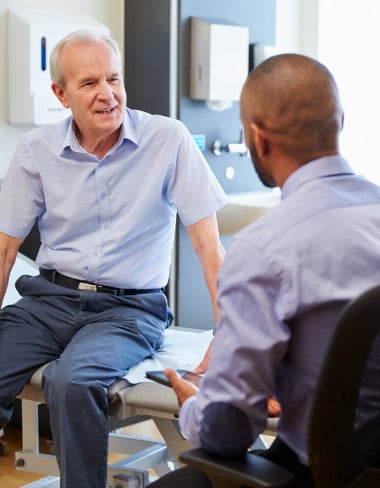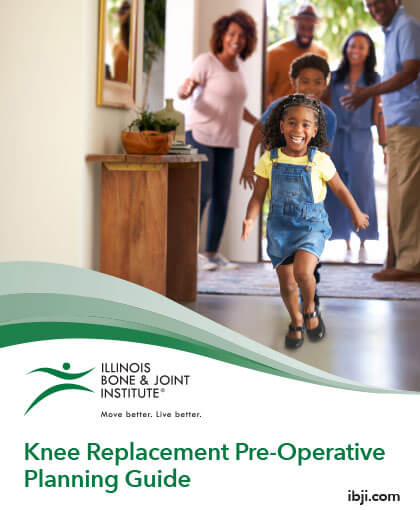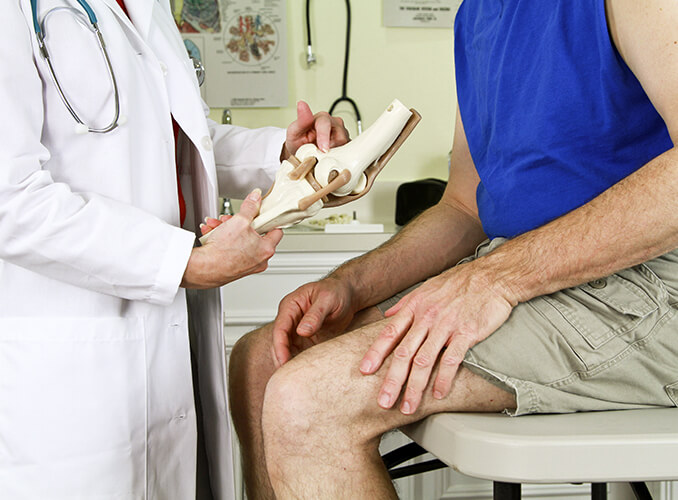Knee Pain: The Ultimate Guide for Finding Relief
Discover what causes common forms of knee pain, and learn when you should see a knee doctor for help getting back to normal activities.
This guide to knee pain relief covers:
Life has enough challenges. Don’t let knee pain be one of them.
Patients of all ages can develop acute and chronic knee pain. The best knee doctors use their knowledge and experience to recommend the best treatments and technologies to help patients find knee pain relief so they can regain physical strength, mobility, and confidence.
Keep reading to find out about options for getting relief to help you move better.
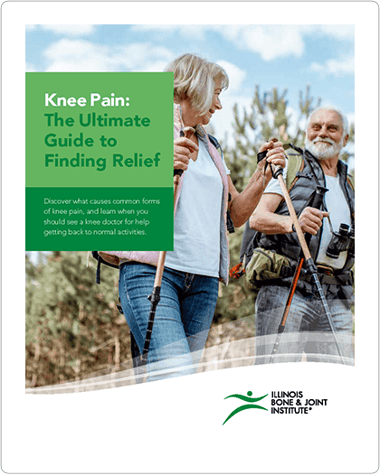
Download your copy of the Ultimate Guide to Knee Pain Relief

Chronic Knee Pain Symptoms
Your knees take a lot of abuse daily. Because they support most of your weight, every time you walk and run, your knee joint is put through a physical test.
In most cases, your knees hold up very well, but occasionally one or both knees may be damaged by injury, illness, or chronic conditions, making it harder to function as painlessly as it should.
Common symptoms for knee pain include:
- Pain
- Swelling
- Redness
- Weakness
- Locking
Learn More About Knee Pain Causes
If home remedies such as over-the-counter pain medication, icing, and resting the knee do not improve the pain, it may be time to seek treatment.
FAQ: Signs of Knee Pain
If there has been no change and no improvement in your knee pain after three weeks, it may be time to see a knee doctor. It is essential not to try to diagnose the specific cause of your knee pain on your own. Any time you are concerned about your pain, you should see a specialist.
If you are not sure if you should see a doctor, there are specific warning signs that you should watch for. If you see any swelling or deformity in your knee, if you can’t fully straighten your leg, if your knee can’t support you, or if you have a fever associated with swelling and redness, you should immediately call an orthopedic physician or visit orthopedic urgent care.
Your doctor will diagnose your condition and devise a treatment plan specifically for you. In mild cases, treatment can be performed at home. Only the most severe problems require a surgical solution, which is typically a last resort.
Anyone can suffer from knee pain for a multitude of reasons. IBJI treats patients of all ages with knee pain whether it’s a sports injury, arthritis, underlying disease, pain from carrying excess weight, or other causes.
Ailments that may be the root cause of your knee pain without having suffered an injury include arthritis, bursitis, tendonitis, wear and tear, and overuse.
It can be, depending on the cause of the pain. For example, if you have pain from arthritis, walking can help ease knee pain as motion sends blood and nutrients to your knee joints.

What Causes Knees to Hurt
Knee pain may stem from a variety of reasons. Some common issues that could be causing your pain include:
- Underlying disease
- Inflammation
- Deformity
- Sprain or strain
- Injury from sport, accident, or fall
- Lack of physical activity
- Carrying excess body weight
- Wear and tear or overuse
Not all knee pain is caused by an underlying disease. For example, you may have taken a fall or had an accident in which you sustained an injury resulting in knee pain. Not having enough physical activity may also cause some discomfort, as well as overuse without proper rest. Additionally, if you are overweight, the excess weight may put more pressure on your knees as you walk and move, resulting in knee pain.
Underlying conditions such as arthritis are another cause of knee pain. You may also have a knee syndrome, such as runner’s knee that is causing your pain.
Learn About the Symptoms, Causes, and Treatments of 4 of the Most Common Knee Conditions
FAQ: Knee Pain Causes
If you had a recent fall or accident, your knee pain might be caused by the impact of the fall. We also encourage you to look at your physical activity.
- Did you pull or twist your knee incorrectly while doing day to day activity or practicing a sport?
- Have you taken a hard fall?
- Is your weight causing added pressure on your knees?
Overall, there could be many reasons why you experience your pain. Examine your knee and what type of activities you’ve done recently which could be attributed to the pain. If you’re unsure of what could be causing your knee pain, it’s time to see a knee specialist for a proper diagnosis.
Seeing a knee doctor will help you find out if an underlying condition causes your knee pain. They will examine your medical history and run multiple tests to determine your knee pain’s cause. Your knee specialist will be able to diagnose you and put you on the right treatment plan.
You may have knee arthritis if you experience a gradual increase in pain, swelling, locking of your knee joint, cracking or popping sounds, lack of range of motion, and a change of appearance in the knee.
A physician who specializes in treating knee pain will order diagnostic tests for a better understanding of the inside of your knee. With these images, they can see the wear and tear of the joint.

When You Should See a Knee Pain Doctor
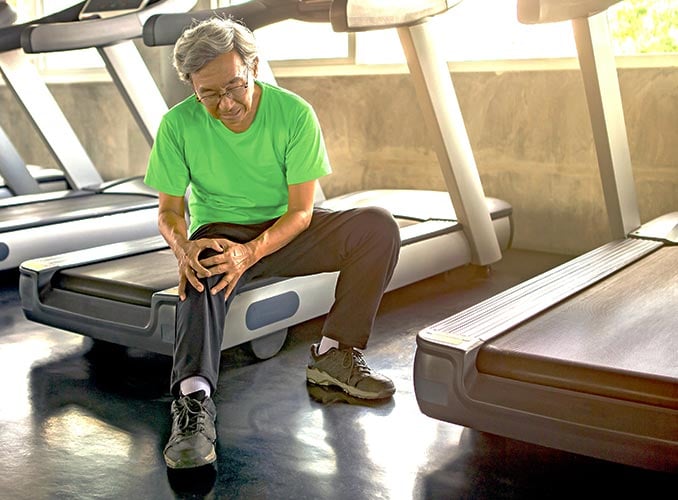
The cause of your knee pain isn’t always easy to self-diagnose. If your pain hasn’t subsided after trying at-home remedies such as rest, ice and over-the-counter anti-inflammatories, it may be time to see a knee doctor.
Consult a knee specialist when you experience:
- Popping or Crunching
- Deformity
- Swelling
- Instability
- Weakness
- Sustained Pain or Discomfort
- Lessened Range of Motion in Your Knee
An experienced orthopedic knee doctor will pinpoint the cause of your knee pain and apply the best knee pain relief treatment for your diagnosis.
Taking the next step to see a knee doctor can dramatically improve your knee pain. In most cases, surgery and knee replacement are not the immediate answer but rather the last option.
A physician who treats knee pain will first try nonsurgical treatments such as medication, cortisone shots, and physical therapy. These treatments are great for relieving and managing pain.
Over time, if these efforts cease to work, it may be time to consider knee surgery or replacement. Your doctor will discuss the best course of action and the next steps for your knee care.
Read Patient Stories

How Knee Pain Is Diagnosed
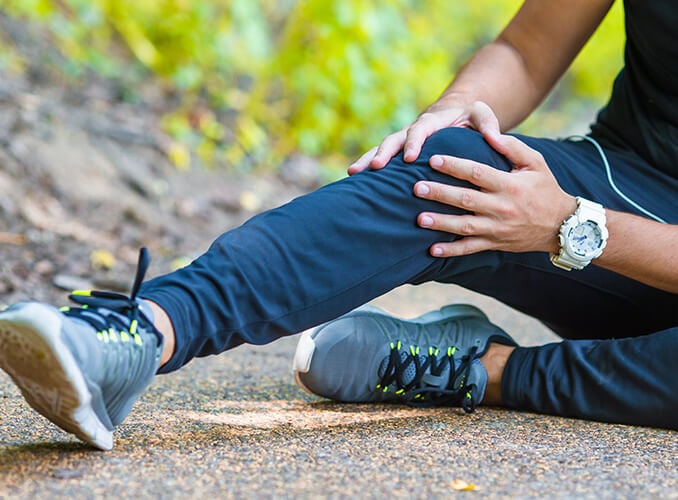
When diagnosing your knee pain, the doctor will perform a physical exam. During this exam, they will examine the knee for swelling, pain, tenderness, and warmth. They will also check your range of motion to see how far you can move your leg and at what point the pain is felt. They may also pull or push on the joint to evaluate the structures within the knee.
Your doctor may be able to diagnose your knee pain without the use of imaging like X-rays, MRI, or CT scans. However, they can be crucial tools for making a diagnosis if your personal history and physical exam are inconclusive.
X-rays provide a look into the condition of the bones that make up your knee (femur, tibia, and patella) and are typically the first type of imaging study to be ordered.
An MRI can show details about soft tissues like cartilage, tendons, muscles, and ligaments in your knee. With an MRI of the knee, doctors can check for any torn ligaments, damaged cartilage, or bone fractures.
A CT Scan will obtain a more detailed cross-sectional image of the body, providing an internal view of the knee without making an incision. Your knee doctor may order one, two, or all three of these imaging tests, depending on the results of other exams.
Once all the necessary information is collected, your doctor will diagnose your condition and devise an individualized treatment plan just for you. In mild cases, treatment can be performed at home with medication, exercises, or physical therapy visits.
For more severe knee problems or advanced deterioration of the joint, your treatment may require a surgical solution, but this is usually a last resort.
ACL injuries
This injury is a tearing of the ACL ligament in the knee joint. The ACL ligament is one of the bands of tissue that connects the femur to the tibia. An ACL tear can be painful. It can cause the knee to become unstable. Minor tears may heal with non-surgical treatments, but complete tears won’t heal without surgery.
Find out how Caroline, a college soccer player, got back on the field after an ACL injury
Discover how Scott, a retired Marine Corps pilot, returned to running marathons after an ACL injury
Knee Sprains
Knee sprains occur from overstretching of the ligaments that support the knee joint. A knee sprain may result when the knee ligaments are twisted or turned beyond their normal range of motion causing the ligaments to tear. Knee sprains are typically treated with RICE (Rest, Ice, Compression, Elevation).
Knee Overuse Injury
Knee overuse injuries occur when the knee performs a repetitive motion. Some examples of overuse injuries of the knee are runner's knee, IT band syndrome, and patellar tendinitis. The RICE method is typically recommended to help promote healing and flexibility of the knee.
Knee Fractures
A fracture is a condition in which there is a break in the bone. These fractures can be caused by injuries from an impact or fall and happen as a result of weak and fragile bones. In most cases, these fractures can be treated with immobilization with a cast or a brace. In more severe cases, surgery may be required.
Torn Meniscus
A torn meniscus is a common knee injury. The meniscus is cartilage between the shinbone and thigh bone. It can be torn when you suddenly twist or rotate your knee while bearing weight on it. In some cases, the RICE method is enough to relieve the pain and allows the injury time to heal on its own. If conservative treatment does not work, it will require surgery.
Learn more about meniscus tears’ causes, symptoms, and treatments
Knee Infections
Knee infections can occur from injury, inflammation, surgery, and other reasons. This is when the fluid that lubricates your knee joint becomes infected. Knee infections are diagnosed by testing the fluid in your knee. They can be treated with antibiotics and draining the fluid in the joint.
Knee Tendonitis
Knee tendonitis, also called jumper’s knee, is an injury to the tissue connecting the kneecap to the shin bone. This condition is common in people who frequently jump, such as athletes.
Treatment may include over-the-counter pain relievers, a patellar tendon strap, or cortisone injections. It is recommended to stay off the knee so that it can heal. In some cases, surgery may be required.
Knee Bursitis
Knee bursitis occurs when the bursa, a small fluid-filled sac in the knee, becomes inflamed. Bursae function as the gliding surface in the joint to reduce friction and provide a cushion between the bones, tendons, and muscles.
RICE will be recommended as well as ceasing the activity that is causing the pain and discomfort.
Patellar Instability
Knee instability results from one or more patella dislocations or partial dislocations. The patella is a small piece of bone in front of the knee that slides up and down the femoral groove during certain movements, such as bending and stretching. The ligaments on the inner and outer sides hold the patella in place to avoid dislocation of the patella from the groove.
Treatment includes RICE, knee bracing nonsteroidal anti-inflammatory drugs, and physical therapy.
Runner’s Knee
Runner’s knee, also called “patellofemoral pain syndrome,” is a pain you feel in the front of your knee. It involves the patella. That’s the bone we commonly call the “kneecap.” The patella slides up and down in a groove on your femur as you bend and extend your knee.
If you have this syndrome, you may have injured the soft tissues that support and cushion your kneecap. Or, you may have some damage to the cartilage on the underside of the kneecap. In many cases, the treatment for runner’s knee is relatively simple.
A knee doctor may just advise you to use RICE and refrain from any activities that are exacerbating the knee pain. A knee doctor may also prescribe anti-inflammatories or physical therapy.
Learn More About Runner’s Knee
How to Prevent & Treat Runner’s Knee
Osteoarthritis
Osteoarthritis, also called degenerative arthritis, is a gradual breakdown of cartilage in the joints, known as wear and tear. Cartilage is a tough, flexible connective tissue that protects the ends of bones in the joints. Osteoarthritis is common in the knees because the knees bear the weight of the body. Osteoarthritis of the knee can severely impact a person’s lifestyle.
Treatments include weight loss, exercise, physical therapy, pain relievers, and sometimes surgery.
Osteoarthritis and Other Common Causes of Knee Pain
Rheumatoid Arthritis (RA)
Rheumatoid arthritis (RA) is a systemic disease of the immune system. In RA, the immune system attacks and damages the lining of the joints resulting in pain, stiffness, and swelling. Treatment includes different medications to help with the pain and inflammation. Regular exercise is also vital to strengthen the muscles that support the joints.
Always consult with your doctor first. Your knee doctor will discuss the best course of treatment for you if you have any of the above conditions.

Knee Pain Treatments & Remedies

In most cases, your orthopedic physician will initially recommend nonsurgical treatments for treating your knee pain. Nonsurgical treatments will help relieve and manage knee pain so you can get back to everyday activities. Only in severe cases, surgery or knee replacement may be required. For many knee injuries, using RICE and refraining from activities will allow your knee time to heal and will significantly reduce pain.
Common nonsurgical treatments include:
- RICE (Rest, Ice, Compression, Elevation)
- Exercise
- Stretching & Strengthening
- Refraining from Activity that Causes Knee Pain
- Over-the-counter Pain Relievers
- Weight Loss
Listen to IBJI OrthoInform Podcast: Rehab for Hip and Knee Arthritis
Dr. Stephen Sutphen discusses how to manage and treat arthritis of the hip and knee

Meet IBJI's Knee Care Patients
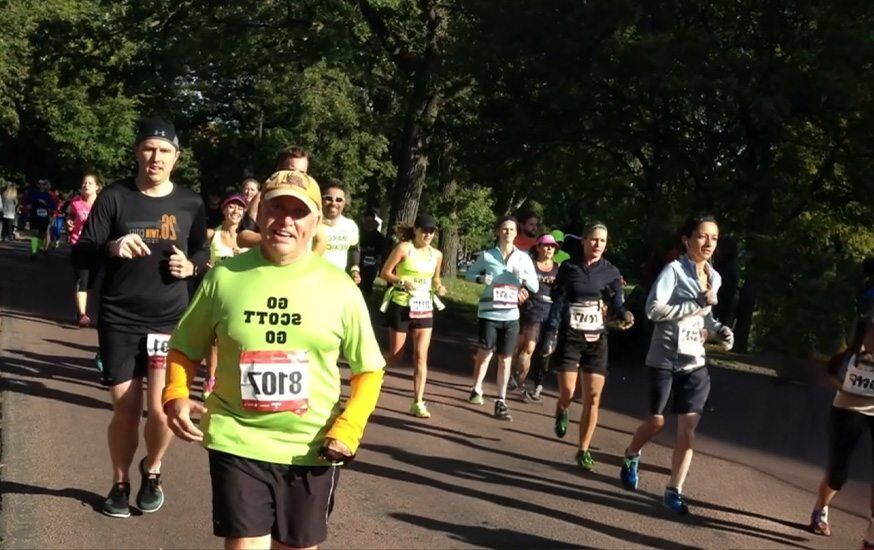
ACL Injury Repair
"I am grateful for the expertise and care that made it possible to get to the finish line!"
- Bryce Chicago Hounds Player Back after Knee Injury
- Linda G., Age 73 Knee Replacement Then vs. Now, 13 Years Apart
- James, Age 70 Superlative Hip and Knee Care in the South Suburbs
- Susan, Age 74 Former U.S. Postal Worker No Longer Limps After Total Knee Arthroplasty
- Marjorie, Age 49 Two-Decades-Old Bilateral Knee Replacement Surgery
- Glenn A. Successful Second Knee Replacement
- Donald G. Total Knee Replacement on Both Knees
- Charlie, Age 75 Total Knee Replacement Surgery
- Kim, Age 63 Effective Knee Care Leads to Enjoyable Retirement
- Ryan, Age 18 Knee Surgery Repair for Competitive Soccer Player
- Christopher Knee Reconstruction Got Me Back to Biking
- Jeffery Knee Replacement Allowed Me to Live a Productive Life
- Judy IBJI Physicians Work Together to Repair Patient

How to Know if It’s Time for Knee Replacement Surgery
It may be time to consider seeing a knee replacement surgeon when all other non-surgical options cease to relieve your pain. For some patients, knee replacement may be delayed by the use of other treatments such as cortisone shots.
We recommend trying nonsurgical treatments before deciding on a knee replacement, as many knee conditions can be resolved without a replacement. Knee replacements are most commonly seen in older patients.
A replacement becomes necessary when:
- Over-the-Counter Medicine Stops
- Relieving the Pain
- Your Knee Hurts When at Rest
- Severe Pain Limits Everyday Activities
- Limited Range of Motion
Learn About the Basics of Knee Replacement Surgery
If you and your knee doctor decide that it is time to consider a knee replacement, they will inform you of all your options and surgery details. Some topics they may cover in this conversation are the benefits of robotic knee replacement, differences in total and partial knee replacement, and outpatient vs. inpatient procedures.
Dr. Marc Angerame shares why you would choose total over partial knee replacement
FAQ: Knee Surgery
No, knee replacement is not the only option to relieve your knee pain. Your knee doctor will try nonsurgical options for your pain before considering surgery. Knee surgery and knee replacement is a last resort solution.
Your doctor will utilize treatments such as over-the-counter pain medications, cortisone shots, exercise, physical therapy, weight loss, and more before deciding to have surgery. In most cases, knee pain can be resolved or managed with the use of nonsurgical treatments.
Typically, our orthopedic knee surgeons at IBJI will advise non-surgical alternatives, but occasionally surgery is necessary. Depending on your level of discomfort, it may be time to consider a total knee replacement. The most common reason for undergoing surgery is due to osteoarthritis of the knee. Knee pain and stiffness from osteoarthritis occur when the bones in the knee begin to rub against one another, and cartilage gets worn down.
The joint is replaced with an artificial hinge prosthesis that will imitate the normal function of a healthy knee.
Learn More About Surgery to Ease Knee Pain From Osteoarthritis
Hear Dr. Jeremy Oryhon discuss the latest advancements in knee replacement surgery
Patients can expect to conduct physical therapy exercises as soon as forty-eight hours post-surgery. Regular activity can resume at around four to six weeks after; however, full recovery can take up to a few months. IBJI’s knee replacement surgeon specialists will walk you through every step pre and post-surgery to assure your full recovery.
View the Typical Timeline for Getting Back to “Normal” After Knee Replacement
A total knee replacement is where the entire knee joint is affected and removed. The whole joint is replaced with an artificial joint. Whereas in a partial knee replacement, only certain affected areas of the joint are removed and replaced with artificial parts.
Inpatient joint replacement means that the patient will be admitted to the hospital to stay overnight or longer to recover from surgery. Physicians keep these patients at the hospital to monitor them more closely.
Outpatient joint replacement does not require hospitalization. Outpatient joint replacement is also known as same-day surgery. This option allows the patient to receive joint replacement surgery in an ambulatory surgical center while being given clearance to return home in just a few hours.
This alternative approach to joint replacement surgery offers patients many benefits previously unavailable with inpatient treatment. Not only can patients return home immediately following surgery, but there is also a lower risk of postoperative infection.
Outpatient surgery reduces out-of-pocket expenses typically billed for extended stays in a hospital and through the recovery process. While outpatient knee replacement surgery is very safe and successful, it is not recommended for everyone.
If you are considering knee replacement surgery, talk to your doctor to determine whether you are a candidate to have outpatient surgery.
Read About JoAnn M.’s Outpatient Knee Replacement Surgery Experience
Double knee replacement is also referred to as a simultaneous bilateral joint replacement. A double knee replacement is where both knees are replaced during the same surgery. This may be recommended if both of your knees are at the point of replacement and you are a healthy candidate for recovery.
Recovery for double knee replacement typically takes 13 weeks when a patient is committed to their rehabilitation.
Hear About Donald G’s Experience Getting Both Knees Replaced
During a knee resurfacing, your knee doctor will shave away the damaged or diseased part of the knee instead of having to undergo replacement surgery. During this, they may insert artificial implants, which will help in cases of pain from arthritis.
Knee arthroscopy is a surgical procedure that your doctor may recommend. An arthroscope, a tiny camera instrument, allows the doctor a better view inside your knee without making a large incision through the skin. Arthroscopies are used to diagnose and treat a wide variety of knee problems.
Meet IBJI’s Knee Pain Specialists
Don’t let knee pain slow you down. You can get back to action with the right help. While some instances of knee pain may resolve with home remedies, it is crucial to get proper knee treatment if your pain affects your mobility. That’s where Illinois Bone & Joint Institute’s knee specialists come in!
Seek treatment from a doctor–especially if your chronic knee pain is altering your day-to-day activities. IBJI’s highly skilled knee doctors will diagnose and treat your pain. They will examine your knee to determine the cause and make the correct diagnosis.
From there, they will make treatment recommendations, and your doctor will include you in deciding which treatments are fit for your specific needs.
Our doctors are eager to answer your questions and see you through every step of your treatment and recovery process. We will exhaust all options to get you back to pain-free activity.
Learn more about IBJI's knee pain care, knee replacement, and joint replacement.
Cutting-edge Treatments & Services
As the premier orthopedic institute in the Midwest, IBJI is the best choice for knee treatment and surgery. Our experienced, compassionate physicians are among the most highly-trained orthopedists in the region.
Our knee doctors will help you move better, so you can live better. If you or someone you love is suffering from knee pain, contact IBJI today.
Find a knee specialist, make your appointment today, and get on the path to recovery.
IBJI's Knee Pain Relief Resources
Begin your journey to knee pain relief with this essential list of resources detailing causes and treatment options. This comprehensive collection of resources, curated by our experienced team of specialists, physical therapists, and surgeons, has empowered thousands across Chicagoland to regain mobility.Downloadable Guides
Videos
- ACL Injuries - Females at More Risk Than Men?
- ACL Injuries on WGN with IBJI's Richard Nicolay, MD
- ACL Injury & Treatment: Does It Require Surgery?
- Acute and Chronic Knee Pain
- Advancements in Knee Replacements
- Caroline's Story: Back to the Soccer Field after ACL Injury
- How to Manage and Treat Arthritis and Other Ailments of the Hip and Knee
- Joint Replacement Surgery on WGN with IBJI's Ritesh Shah, MD
- Jumper's Knee - Pain in the Center of Your Knee?
- Knee Meniscus Tear - How to Tell if You Possibly Tore Your Meniscus
- Knee Pain and Injuries
- Knee Pain Causes & What You Can Do
- Knee Replacement Peter Thadani MD
- Knee Replacement Surgery
- Knee Surgery- How to Make a Full Recovery Faster
- Meniscus Tears – Causes, Symptoms and Treatment
- Osgood Schlatter Disease - What You Need to Know
- Partial or Total Knee Replacement with IBJI’s Marc Angerame, MD
- Patellar Tendon Ruptures and Treatment Options
- Patellar Tracking Disorder
- Scott’s Story: An Inspiring Comeback From ACL Injury
- Ryan’s Story: Knee Surgery Repair Student-Athlete
- What is an ACL injury? - A Discussion with an IBJI Orthopedist
- What is Runner's Knee?
Blog Articles
- 4 Common Knee Conditions—Symptoms, Causes and Treatments
- Al Roker Shows Viewers How Far Knee Replacement Has Come
- Arthritis in Knee: 4 Stages of Osteoarthritis
- Bone-on-Bone Knee Pain Relief: What you Need to Know About Knee Replacement
- Chicago Bears’ Zach Miller Suffers Gruesome Knee Injury
- Empowering Mobility with Robotic Hip and Knee Replacement
- Four Common Knee Injuries
- Good Exercises for Bad Knees
- How to Prevent & Treat Runner’s Knee
- IBJI a 'One Stop Shop' for Girl's Concussion and Torn Knee Ligament
- IBJI Welcomes Two Physicians with Specialties in Hip/Knee Surgery and Interventional Pain Medicine
- Knee Arthroscopy Explained – The Less Invasive Knee Surgery
- Knee Cap Won't Stay Put? It May Be Patellar Tracking Disorder
- Knee Replacement Recovery: What to Expect after Knee Surgery
- Knee Replacement Surgery Basics - What you Need to Know
- Managing Knee Pain This Fall
- Osteoarthritis and Other Common Causes of Knee Pains
- Runner’s Knee: What Is It? How Is It Treated?
- Surgery to Replace a Bad Joint: How a Knee Replacement Is Done
- Tips to Prevent Runner's Knee This Summer
- Training Harder and Better After My Hip and Knee Replacement Surgeries (David)
- What Are the Different Types of Knee Replacements?
- What Causes Knee Pain (and What You Can Do)
- What to Expect after Knee Replacement Surgery
- What to Expect with Knee Osteoarthritis Surgery and Other Knee Arthritis Treatments
- Women More Likely to Injure ACL Than Men
